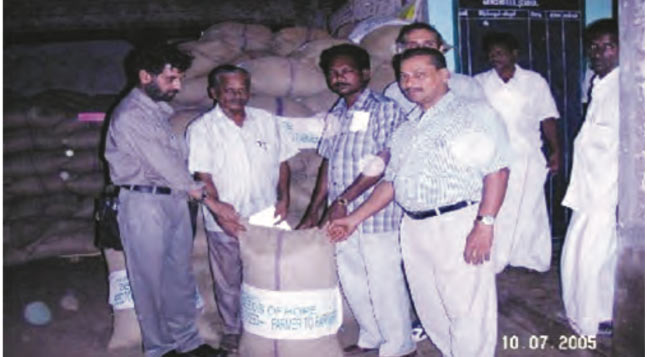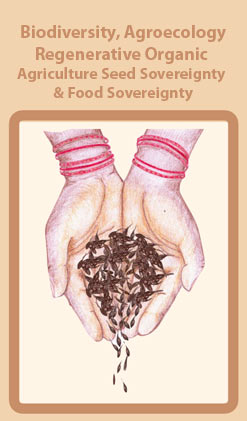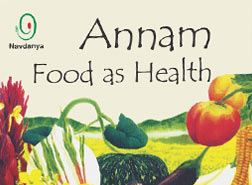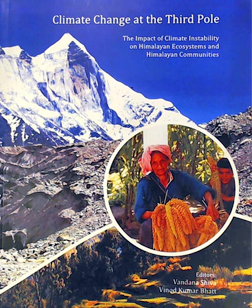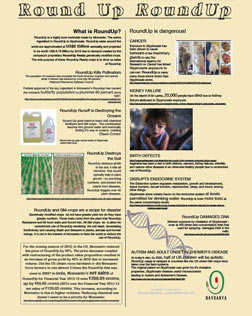How Biodiversity makes Agriculture and Communities more Resilient to Climate Change
There are 4 ways in which Biodiversity and Seed Freedom creates climate resilience and is a climate solution.
- Firstly farmers have bred Climate Resilient Seeds and varieties that are contributing to resilience.
- Secondly, Diversity of crops increases the resilience of farming to climate change. If you have only one crop in a monoculture, it is more vulnerable to changing climate. Farmers growing monocultures of commodity crops are also more vulnerable to exploitative markets.
- Thirdly, biodiversity intensification allows more carbon to be absorbed from the air, returned to the soil, thus decreasing excess carbon in the atmosphere while also increasing the resilience of soils to draught, floods and climate change.
- Fourthly, when farmers have their own renewable, regenerative seed, they can replant after a climate disaster, which contributes to both climate resilience and economic resilience. If farmers are dependent on purchase of costly non renewable seeds from corporations, not only do they loose their crop, they loose their sovereignty and have to get into debt. Debt is the single biggest reason for the more than 300,000 farmers suicides in India since 1995.
Farmers innovation and climate resilient Seeds: Climate change requires farmers’ breeding and local adaptive strategies
Plant breeding plays an essential role in adapting agriculture to rapidly changing climates. Even when formal sector scientists use the most sophisticated climate models and the most advanced technologies, the reality is that they are not very good at predicting what happens at a very local level and on the ground realities. While genetic uniformity is the hallmark of commercial plant breeding, farmer-breeders, rooted in local level realities, deliberately create and maintain more heterogeneous varieties in order to withstand diverse and adverse agroecological conditions. The crop diversity developed and maintained by farming communities already plays a role in adapting agriculture to climate change and variability. Additionally, farmers adapt quickly to changing climates by shifting planting dates, choosing varieties with different growth duration, changing crop rotations, diversifying crops, and using new irrigation systems among other strategies. Farmer-led strategies for climate change survival and adaptation must be recognised, strengthened and protected. Farming communities must be directly involved in setting priorities and strategies for adaptation.
Farmers’ knowledge and technology have never been stagnant or static. They have always skilfully responded to the changing circumstances and have kept their system in a dynamic state advancing towards higher degree of diversity, complexity, resilience, sustainability, and security. In the process of achieving these goals, farmers have always based their livelihood systems on natural biodiversity. They unabatedly searched, selected, cultivated, bred, preserved, protected, saved, conserved, experimented with, managed, used, enriched, shared, distributed, and disseminated the germ plasm, which is the living testimony of their innovations. Not only this, they also dutifully passed this germ plasm on to the next generations.
Systematic modern agricultural experiments are just about half century old, whereas farmers’ experiences are millennia old. They cannot be ignored or rejected as mere remnant of the past. Farmers’ knowledge and technology are futuristic and innovative and are governed by ecological laws. They must end central place in our contemporary agricultural strategies. Recent advances in technology will be welcome provided they have compatibility with those evolved by farmers and are rooted in local realities (Singh et.al 2013). While highly expensive High yielding seeds, hybrid seeds and GMO’s continue to fail, indigenous open pollinated climate resilient varieties are proving to be an important option for adaptation to climate change. Evidence from farmers fields prove that indigenous crop varieties can withstand a wide range of climatic and soil conditions, whereas “modern” crop varieties tend to perish at small environmental variations like rains arriving too early or too. Farmers varieties grown by traditional farmers continue to evolve to adapt to changing environmental conditions. With the disappearance of biodiversity due to industrial monocultures, the very genetic base for crop breeding for climate resilience is being irretrievably lost. Fearing the loss of valuable genes, conservationists have launched efforts to collect and save folk crop seed samples for future use in ex situ gene banks (Jackson, 1995).
Navdanya’s experience of working with farmers across the county reveals that climate resilient seeds with organic farming are better than “high yielding” seeds in chemical farming. Recent study done by Navdanya in Odisha, Bundelkhand, Uttarakhand and Maharashtra confirms that open pollinated Indigenous seeds are better alternatives to the hybrid, high yielding or GM seeds. Hundreds of farmers in Odisha those who were given indigenous seeds by Navdanya after the Phailin super cyclone, got very good yields.
As an insurance against such vulnerability Navdanya has pioneered the conservation of biodiversity in India and built a movement for the protection of small farmers through promotion of ecological farming and fair trade to ensure the healthy, diverse and safe food. Navdanya’s program for promoting ecological agriculture is based on biodiversity, for economic and food security. Today as a result of Navdanya’s pioneering work many small groups and entrepreneurs have entered in the eld of biodiversity conservation, organic farming and marketing of organic food products.
Navdanya’s experience of working with farmers across the country and Bhutan established that through adopting the principles of agroecology and biodiversity based organic farming farmers could not only increase their yields by 2 to 3 times but vis-à-vis can reduce their input costs. Indigenous open pollinated varieties are not only capable of producing more but are also resilient to the climate. Comparative studies of 22 rice-growing systems have shown that indigenous systems are more efficient in terms of yields, and in terms of labour use and energy use (Shiva & Pandey 2006).
Researchers’ world over has already proven the importance of indigenous crops and organic farming practices in coping with the changing climatic conditions. Results of our studies in the past in different agro climatic situations concerns that even in the adverse climatic conditions biodiversity based organic farming (higher crop diversity) is better capable to minimise the crop losses than that of monoculture based industrial farming. Climate resilient traits will become increasingly important in times of climate instability. Along coastal areas, farmers have evolved flood tolerant and salt tolerant varieties of rice such as “Bhundi”, “Kalambank”, “Lunabakada”, “Sankarchin”, “Nalidhulia”, “Ravana”, “Seulapuni”, “Dhosarakhuda”.
Crops, such as millets, have been evolved for drought tolerance, and provide food security in water scare regions, and water scarce years. Corporations like Monsanto have take 1500 patents on Climate Resilient crops. Navdanya/Research Foundation for Science, Technology and Ecology, have published the list in its report, “Biopiracy of Climate Resilient Crops: Gene Giants Steal Farmers Innovation”.
Navdanya decided to save these vanishing rice diversities of Odisha through a system of germ-plasm -conservation employing both in situ and ex situ methods and at the same time carry out experiments on their sustainability in varied eco-climatic conditions in view of rapid climate change and yield potentials under various soil amendments. Their behaviours and responses are being recorded. This came handy while selecting the seeds of specific rice diversities for empowering the local communities in rehabilitating agriculture in disaster areas like Erasama in Odisha after the Orissa super cyclone in 2000, Nagapattinam in Tamilnadu after the boxing day tsunami in 2005 and Nandigram in Bengal in 2007.
Navdanya has also given hope to the victims of tsunami. The tsunami waves a affected the agricultural lands of the farmers due to intrusion of seawater and deposition of sea land. More than 5203.73 hectare of agricultural land in Nagapattinam was affected by the tsunami. The Navdanya team conducted a study in the affected villages to facilitate the agriculture recovery. Thee team, distributed 3 saline resistant varieties of paddy, which included Bhundi, Kalambank and Lunabakada, to the farmers of the worse affected areas. These varieties of native saline resistant kharif paddy seeds were collected from Navdanya farmers in Orissa amounting to a total of 100 quintals.
Navdanya Odisha as of now maintains 4 seed banks, 3 village level and 1 central level, where seeds of diverse rice varieties are conserved and renewed every year. Climate resilience factor is given importance in the village level seed banks when all available rice land races are conserved in the central seed bank. Navdanya also encourages individual cultivators to save, exchange and increase diversities in his/ her own yields. The village level seed banks are located in different and varied eco-climatic zones, like salt prone, flood prone and drought prone areas. e central seed bank has 810 rice varieties in its accession out of which 119 varieties are climate resilient. 33 of these are salt and flood tolerant including 1 aromatic variety, 47 are flood tolerant and 39 are drought tolerant including 3 aromatic and 2 therapeutic rice varieties. rest 581 varieties belong to the general category. There are 56 aromatic rice varieties of which 2 have unique and diverse aroma, 1 smelling like fried green gram and the other, like cumin seed not available anywhere in the world. The therapeutic rices are used in old age tissue rejuvenation.
Seed exchange has been the back bone of paddy cultivation until the green revolution. Native paddy plants have diverse basal sheath colours, with about 9 shades of 5 colours, ranging from green, yellow, purple, violet to black. Reappearance of wild variety is an inherent character of paddy cultivation. Cultivators, hence, replace the variety with a different basal sheath colour next season just to be able to distinguish the weeds which are then manually removed. All the green revolution varieties have the same basal sheath colour, making it difficult to distinguish the wild weed which is never removed. A particular variety cultivated in a given field for more than 3 years lose yield, hence, is replaced. This replacement used to be procured through seed exchange, a part of the barter system that was in place till a few decades ago. Thus the cultivators used to gain twice, a new variety and an ensured more yield as the new variety always yielded more. The green revolution proponents do not contribute to this gospel truth. It has been further found out that seeds exchanged over a long distance for growing in the same type of micro-climate not only yielded much more but often even changed its potentials.
Climate resilient seeds to cope with climate change
With the increasing events of disasters, we started conserving climate resilient seeds. We also encouraged farmers to grow and multiply native climate resilient varieties and started a program “Seeds of Hope” to help the disaster affected farmers with the climate resilient seeds.
It is predicted that 4°C increase in temperature due to climate change will reduce rice yield by 10%. Rice has been found to be quite climate resilient. Rice as a crop originally nourished in the dry climate of central Asia, and later spread to the wet tropical Asia, thus evolved the low land rice varieties with better yield.
Odisha is very well known for its rice diversity; therefore Odisha was selected for the conservation and multiplication of climate resilient paddy and vegetable seeds. Climate resilient varieties conserved by Navdanya in Odisha are given below:
Salt tolerant varieties
Navdanya has conserved 33 salt tolerant varieties. Odisha salt tolerant rice land races have caused miracle both in Nagapattinam and Indonesia (post tsunami) where some of them such as Lunabakada, Kalambank, Bhundi, and Dhala sola have on an average produced 35-54 tillers in the SRI method.
Flood tolerant varieties
In last 20 years Navdanya has conserved 54 flood tolerant varieties in Odisha. Of these 8 varieties are extremely water tolerant. These varieties are being conserved and multiplied at Navdanya’s biodiversity conservation farm and Seed Bank in village Chandipur, Balasore as well as by the Navdanya member farmers in Odisha.
Drought tolerant varieties
It is one of most serious worldwide problems for agriculture owing to very less rainfall. About 4/10th of the World’s agricultural land lies in arid and semiarid regions, where less water demanding crops like millets, pulses and oil seeds are cultivated. Plants of these climate resilient native rice varieties have long vertical roots, no lateral roots with least leaf curling (drought stress). Plants of the short duration variety normally are drought tolerant to some extent. Navdanya is conserving 39 drought tolerant rice varieties in Odisha.
Drought resistant aromatic and therapeutic rice varieties
Besides, there are two other unique rice varieties, such as Differently Aromatic rice varieties (plenty) and Therapeutic (medicinal) rice varieties (few). Aromatic rice varieties have the ability to sustain in water deficit conditions (semi drought) unlike other normal longer days duration paddy varieties. Therapeutic rice varieties also sustain drought to considerable extent. Navdanya has conserved 55 aromatic and 2 therapeutic rice varieties in Odisha. These varieties have been produced through the Darwinian factors as Natural selection and Artificial selection with mutation over centuries.
Climate resilient Odisha rice varieties have performed exceedingly well on introduction in disaster areas such as Ersama in Odisha, Nagapattinam in Tamil Nadu and in Indonesia with respect to their tillering behaviours; 10 in Balasore, 14 in Ersama, 35 in Nagapattinam and 54 in Indonesia. (Last 2 under SRI method of cultivation). Currently in Odisha we are conserving 804 varieties of native Paddy, of these 184 varieties are climate resilient.
Hundreds of quintals of seeds of food and salt tolerant diverse rice land races from Navdanya’s Odisha Seed bank and Seed keepers have been provided to disaster hit farmers in post Orissa super cyclone at Ersama and Astarang in Odisha, post Indian ocean tsunami at Nagapattinam in Tamil Nadu, Nandigram in West Bengal and also to Indonesian farmers. In 2013 after the massive destruction of standing rice crop in coastal Odisha by cyclone Phailin, Navdanya also distributed 20 flood and salt tolerant indigenous rice seeds to farmers of Balasore and Mayurbhanj districts.
Navdanya was able to save climate resilient seed varieties throughout the country. During last more than 2 decades of our experience of working with farmers in different agro-ecological zones confirm that.
Navdanya in August 2006 established seed banks in Jaisalmer (drought resistant crops), Orissa (saline, drought and flood resistant rice) to help with various dimensions of preparedness in the face of extreme climate changes like the foods in Barmer (Rajasthan). In the year 2007 Navdanya established a seed bank at village Bajkul under disaster hit Nandigram block in Midinapur district of West Bengal. In these community seed banks Navdanya is saving and multiplying indigenous climate resilient varieties of different crops. We are currently multiplying seeds of cereals, millets, pseudo cereals, pulses, oilseeds, fruits and vegetables.
Climate resilient Odisha rice varieties have per- formed exceedingly well on introduction in disaster areas such as Ersama in Odisha, Nagapattinam in Tamil Nadu and in Indonesia with respect to their tilleringbehaviours; 10 in Balasore, 14 in Ersama, 35 in Nagapattinam and 54 in Indonesia. (Last 2 under SRI method of cultivation). Currently in Odisha we are conserving 804 varieties of native Paddy, of these 184 varieties are climate resilient. Climate resilient varieties conserved by Navdanya in Odisha are given below:
Salt tolerant rice varieties
In Odisha the seasons have become unpredictable; the quantum and frequency of rains, droughts and saline inundations have increased substantially. Consequently, paddy as a crop is getting affected, but it is more so with the so called hybrids and high yielding varieties. However, the climate adapted rice varieties so evolved naturally sustain the impacts of climate change and maintain yield. Photo above (Sartha estuary, Orissa) substantiate the above statement. Researches currently being carried out in India and abroad to develop climate tolerant rice varieties is unnecessary. Conservation and propagation of the climate adapted varieties is necessary.
PPBSA - NAVDANYA, ORISSA ACCESSION AND CONSERVATION OF SALT TOLERANT RICE VARIETIES
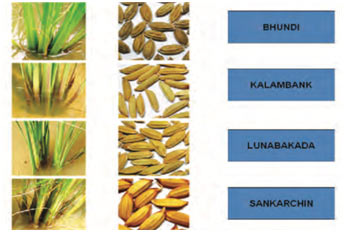
Flood Tolerance
Rice as a crop was brought from the arid areas to the coastal plains centuries ago. e tall indica rice varieties, thus evolved, have the ability to survive sub-
PPBSA - NAVDANYA, ORISSA ACCESSION AND CONSERVATION OF FLOOD TOLERANT RICE VARIETIES
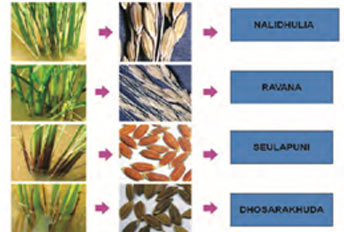
Some varieties are more able to withstand complete submergence for days together. A gene named “sub IA” has been identified in these rice varieties. Such genes have been evolved naturally in these rice varieties which are cultivated in predominantly sub merged coastal flood plains of Orissa where the crop plants remain wholly under water for days together yet survive to hand over a good yield.
Drought tolerant rice
Orissa is endowed with some drought tolerant rice varieties, a few of which are of high therapeutic impotence. Drought stress crops exhibit inhibition of lateral root development as an adaptive response to the stress. The drought response is mediated by a gene that produces the phyto–hormone, “abscisic acid” which prevents lateral root development. Drought tolerant rice varieties do not exhibit much tillering and are of shorter day durations.
PPBSA - NAVDANYA, ORISSA ACCESSION AND CONSERVATION OF DROUGHT TOLERANT RICE VARIETIES
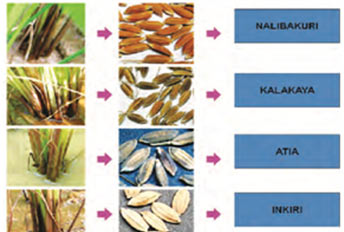
Seeds of Hope for natural calamities
Seeds of Hope (AshaKeBija) program of Navdanya aim at providing an emergency supply of indigenous varieties of seeds in those regions, which are worse effected, either by the natural calamities or as result of the policies. Under the program, Navdanya continues its efforts to supply seeds to those who are in the need of it and have lost their local varieties due to natural disaster or Green Revolution policy of the government.
Orissa super cyclone 1999
During the Odisha super cyclone in 1999 Navdanya provided the victims with total of 100 quintals of paddy seeds of 14 varieties of native and nativised paddy in 3 devastated villages, namely Talang, Dharijan and Junagari under Gadabishnupur GP in Ersama block of Jagatsingpur district on 27th May 2000 through the ChachakhaiYubakSangh and one such village, Manduki under Astranga block of Puri district on 28th May 2000. Other than paddy native vegetable seeds were also given to the farmers and district administration for free distribution.
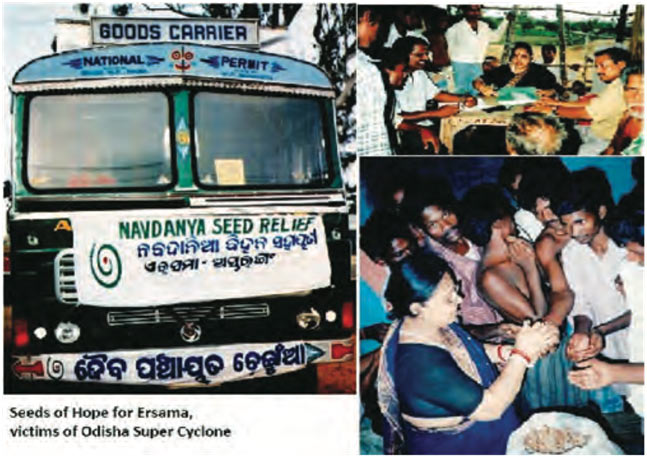
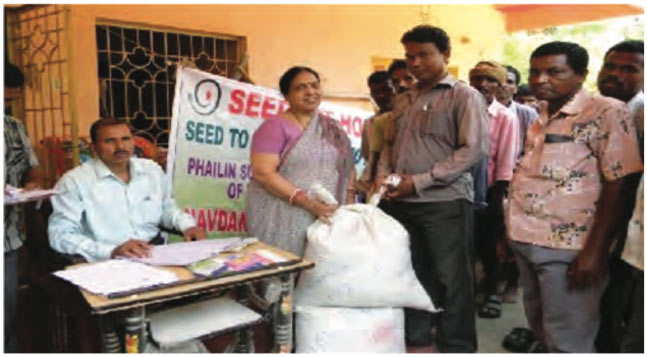
Tsunami, 2004
During Tsunami in the year 2004 Navdanya Odisha gained 100 quintals saline resistant native paddy diversity of 3 varieties to the Joint Director of Agriculture, Nagapattinam, Tamilnadu for free distribution of on 9th July 2005 at Nagapattinam.
Phailin, 2013
A er the massive destruction of standing rice crop in coastal Odisha in 2013 by cyclone Phailin, Navdanya distributed 100 quintals of 20 flood and salt tolerant indigenous rice seeds to 400 farmers of Balasore and Mayurbhanj districts.
Nepal earthquake 2015
On the 25th of April 2015 an earthquake of 7.6 Richter’s struck Nepal. e a aftershocks followed and a second quake measuring of 7.3 Richter’s struck on the 12th of May killing over 9000 people. Navdanya provided about 2000 farmers with seeds of paddy, maize, millets and vegetables.
